Higher Education: Reflective Learning Through Feedback Mechanisms
VerifiedAdded on 2023/06/16
|7
|1790
|98
Essay
AI Summary
This essay discusses reflective learning as a method of learning through experiences and self-analysis, emphasizing its role in improving performance and identifying areas for improvement. It highlights the importance of feedback and feedforward in the learning process, with feedback providing constructive criticism and feedforward focusing on future actions to achieve goals. The essay references the Gibbs reflective cycle as a framework for learning from experiences and stresses the significance of formative feedback in enhancing student learning and teaching. Ultimately, the reflective approach to learning can assist individuals in evaluating their performance and identifying flaws that can be used to make additional improvements in their educational journey. Desklib provides past papers and solved assignments for students.
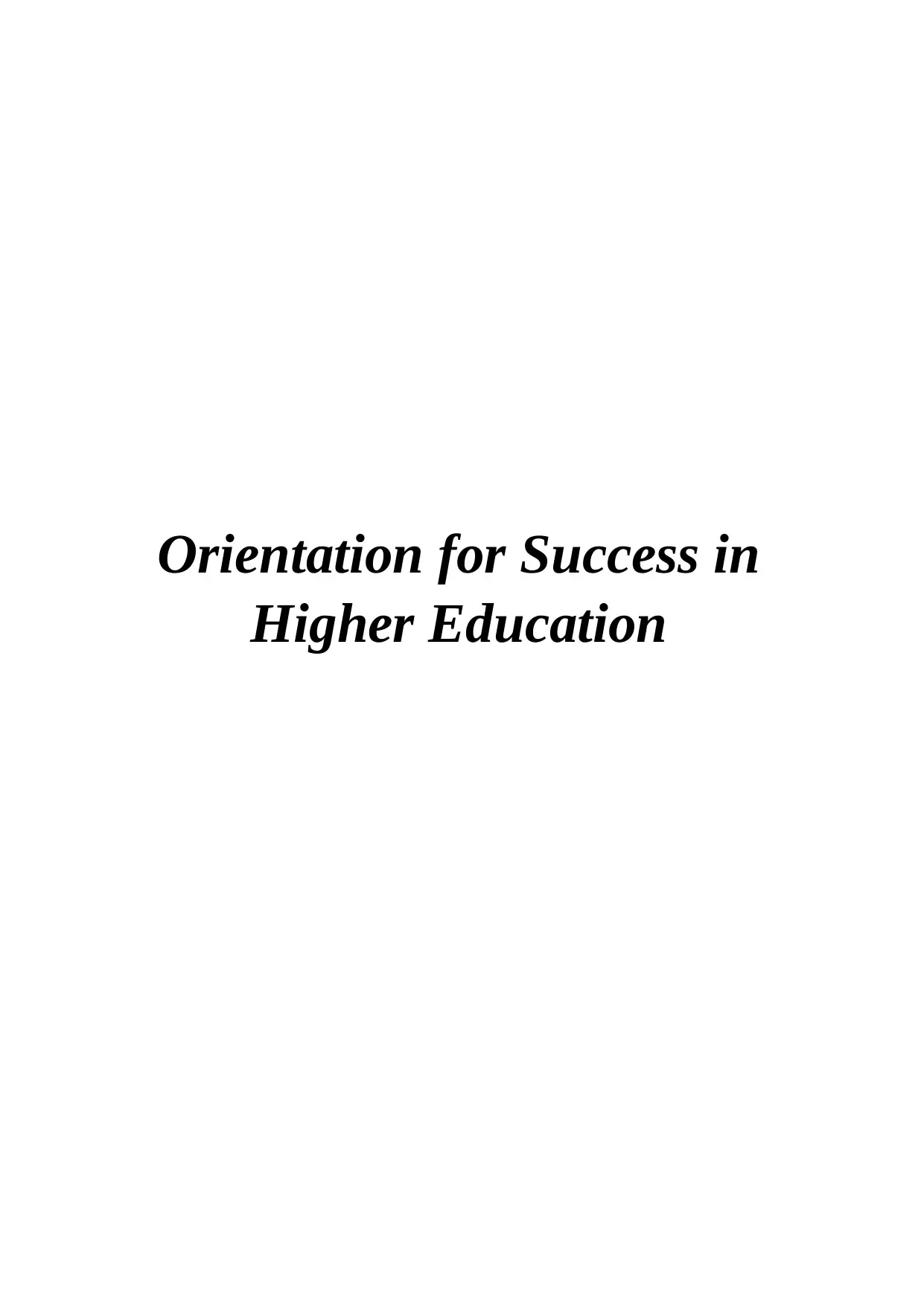
Orientation for Success in
Higher Education
Higher Education
Paraphrase This Document
Need a fresh take? Get an instant paraphrase of this document with our AI Paraphraser

Table of Contents
INTRODUCTION................................................................................................................................3
MAIN BODY........................................................................................................................................3
CONCLUSION.....................................................................................................................................5
REFERENCES.....................................................................................................................................6
INTRODUCTION................................................................................................................................3
MAIN BODY........................................................................................................................................3
CONCLUSION.....................................................................................................................................5
REFERENCES.....................................................................................................................................6
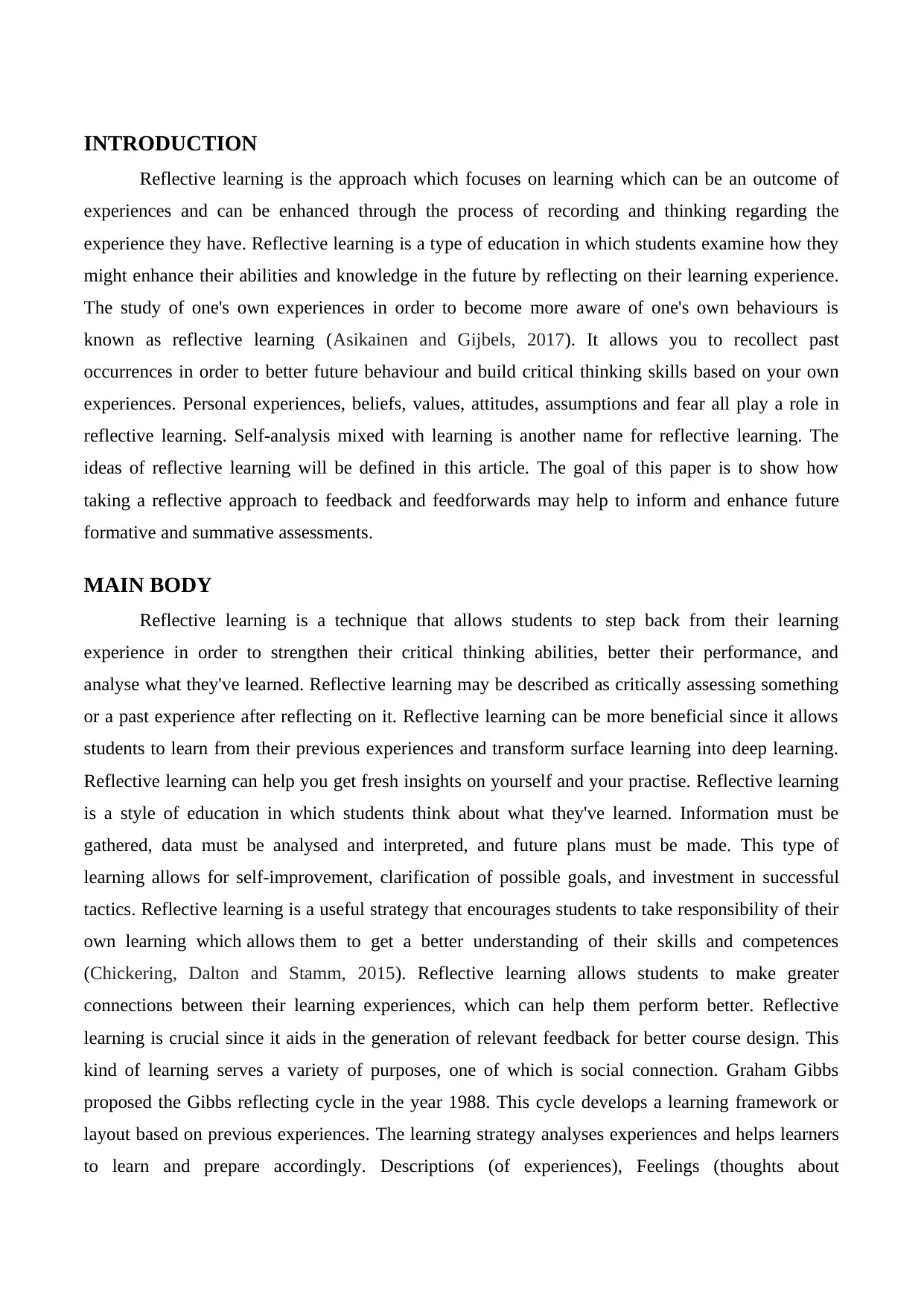
INTRODUCTION
Reflective learning is the approach which focuses on learning which can be an outcome of
experiences and can be enhanced through the process of recording and thinking regarding the
experience they have. Reflective learning is a type of education in which students examine how they
might enhance their abilities and knowledge in the future by reflecting on their learning experience.
The study of one's own experiences in order to become more aware of one's own behaviours is
known as reflective learning (Asikainen and Gijbels, 2017). It allows you to recollect past
occurrences in order to better future behaviour and build critical thinking skills based on your own
experiences. Personal experiences, beliefs, values, attitudes, assumptions and fear all play a role in
reflective learning. Self-analysis mixed with learning is another name for reflective learning. The
ideas of reflective learning will be defined in this article. The goal of this paper is to show how
taking a reflective approach to feedback and feedforwards may help to inform and enhance future
formative and summative assessments.
MAIN BODY
Reflective learning is a technique that allows students to step back from their learning
experience in order to strengthen their critical thinking abilities, better their performance, and
analyse what they've learned. Reflective learning may be described as critically assessing something
or a past experience after reflecting on it. Reflective learning can be more beneficial since it allows
students to learn from their previous experiences and transform surface learning into deep learning.
Reflective learning can help you get fresh insights on yourself and your practise. Reflective learning
is a style of education in which students think about what they've learned. Information must be
gathered, data must be analysed and interpreted, and future plans must be made. This type of
learning allows for self-improvement, clarification of possible goals, and investment in successful
tactics. Reflective learning is a useful strategy that encourages students to take responsibility of their
own learning which allows them to get a better understanding of their skills and competences
(Chickering, Dalton and Stamm, 2015). Reflective learning allows students to make greater
connections between their learning experiences, which can help them perform better. Reflective
learning is crucial since it aids in the generation of relevant feedback for better course design. This
kind of learning serves a variety of purposes, one of which is social connection. Graham Gibbs
proposed the Gibbs reflecting cycle in the year 1988. This cycle develops a learning framework or
layout based on previous experiences. The learning strategy analyses experiences and helps learners
to learn and prepare accordingly. Descriptions (of experiences), Feelings (thoughts about
Reflective learning is the approach which focuses on learning which can be an outcome of
experiences and can be enhanced through the process of recording and thinking regarding the
experience they have. Reflective learning is a type of education in which students examine how they
might enhance their abilities and knowledge in the future by reflecting on their learning experience.
The study of one's own experiences in order to become more aware of one's own behaviours is
known as reflective learning (Asikainen and Gijbels, 2017). It allows you to recollect past
occurrences in order to better future behaviour and build critical thinking skills based on your own
experiences. Personal experiences, beliefs, values, attitudes, assumptions and fear all play a role in
reflective learning. Self-analysis mixed with learning is another name for reflective learning. The
ideas of reflective learning will be defined in this article. The goal of this paper is to show how
taking a reflective approach to feedback and feedforwards may help to inform and enhance future
formative and summative assessments.
MAIN BODY
Reflective learning is a technique that allows students to step back from their learning
experience in order to strengthen their critical thinking abilities, better their performance, and
analyse what they've learned. Reflective learning may be described as critically assessing something
or a past experience after reflecting on it. Reflective learning can be more beneficial since it allows
students to learn from their previous experiences and transform surface learning into deep learning.
Reflective learning can help you get fresh insights on yourself and your practise. Reflective learning
is a style of education in which students think about what they've learned. Information must be
gathered, data must be analysed and interpreted, and future plans must be made. This type of
learning allows for self-improvement, clarification of possible goals, and investment in successful
tactics. Reflective learning is a useful strategy that encourages students to take responsibility of their
own learning which allows them to get a better understanding of their skills and competences
(Chickering, Dalton and Stamm, 2015). Reflective learning allows students to make greater
connections between their learning experiences, which can help them perform better. Reflective
learning is crucial since it aids in the generation of relevant feedback for better course design. This
kind of learning serves a variety of purposes, one of which is social connection. Graham Gibbs
proposed the Gibbs reflecting cycle in the year 1988. This cycle develops a learning framework or
layout based on previous experiences. The learning strategy analyses experiences and helps learners
to learn and prepare accordingly. Descriptions (of experiences), Feelings (thoughts about
⊘ This is a preview!⊘
Do you want full access?
Subscribe today to unlock all pages.

Trusted by 1+ million students worldwide
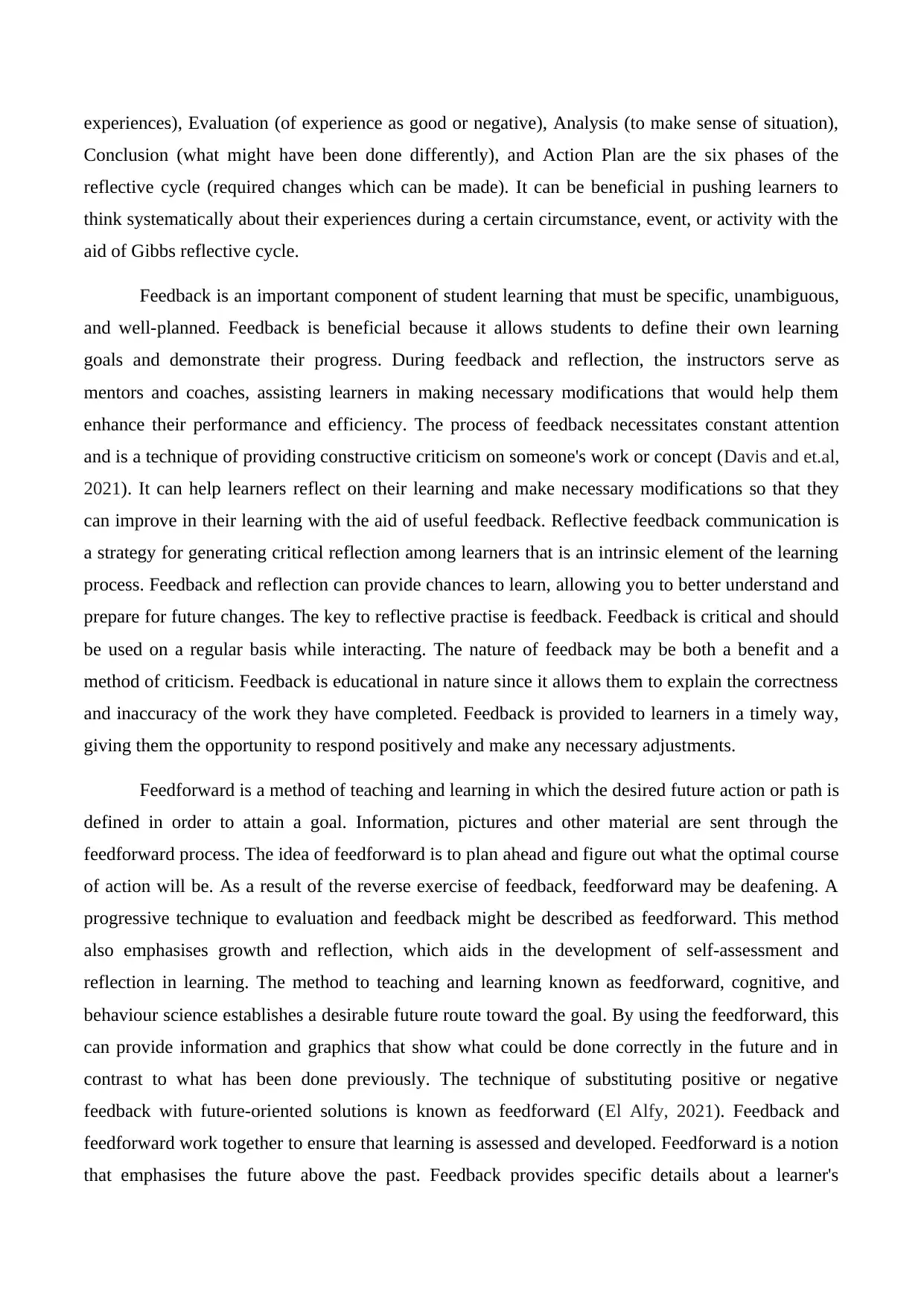
experiences), Evaluation (of experience as good or negative), Analysis (to make sense of situation),
Conclusion (what might have been done differently), and Action Plan are the six phases of the
reflective cycle (required changes which can be made). It can be beneficial in pushing learners to
think systematically about their experiences during a certain circumstance, event, or activity with the
aid of Gibbs reflective cycle.
Feedback is an important component of student learning that must be specific, unambiguous,
and well-planned. Feedback is beneficial because it allows students to define their own learning
goals and demonstrate their progress. During feedback and reflection, the instructors serve as
mentors and coaches, assisting learners in making necessary modifications that would help them
enhance their performance and efficiency. The process of feedback necessitates constant attention
and is a technique of providing constructive criticism on someone's work or concept (Davis and et.al,
2021). It can help learners reflect on their learning and make necessary modifications so that they
can improve in their learning with the aid of useful feedback. Reflective feedback communication is
a strategy for generating critical reflection among learners that is an intrinsic element of the learning
process. Feedback and reflection can provide chances to learn, allowing you to better understand and
prepare for future changes. The key to reflective practise is feedback. Feedback is critical and should
be used on a regular basis while interacting. The nature of feedback may be both a benefit and a
method of criticism. Feedback is educational in nature since it allows them to explain the correctness
and inaccuracy of the work they have completed. Feedback is provided to learners in a timely way,
giving them the opportunity to respond positively and make any necessary adjustments.
Feedforward is a method of teaching and learning in which the desired future action or path is
defined in order to attain a goal. Information, pictures and other material are sent through the
feedforward process. The idea of feedforward is to plan ahead and figure out what the optimal course
of action will be. As a result of the reverse exercise of feedback, feedforward may be deafening. A
progressive technique to evaluation and feedback might be described as feedforward. This method
also emphasises growth and reflection, which aids in the development of self-assessment and
reflection in learning. The method to teaching and learning known as feedforward, cognitive, and
behaviour science establishes a desirable future route toward the goal. By using the feedforward, this
can provide information and graphics that show what could be done correctly in the future and in
contrast to what has been done previously. The technique of substituting positive or negative
feedback with future-oriented solutions is known as feedforward (El Alfy, 2021). Feedback and
feedforward work together to ensure that learning is assessed and developed. Feedforward is a notion
that emphasises the future above the past. Feedback provides specific details about a learner's
Conclusion (what might have been done differently), and Action Plan are the six phases of the
reflective cycle (required changes which can be made). It can be beneficial in pushing learners to
think systematically about their experiences during a certain circumstance, event, or activity with the
aid of Gibbs reflective cycle.
Feedback is an important component of student learning that must be specific, unambiguous,
and well-planned. Feedback is beneficial because it allows students to define their own learning
goals and demonstrate their progress. During feedback and reflection, the instructors serve as
mentors and coaches, assisting learners in making necessary modifications that would help them
enhance their performance and efficiency. The process of feedback necessitates constant attention
and is a technique of providing constructive criticism on someone's work or concept (Davis and et.al,
2021). It can help learners reflect on their learning and make necessary modifications so that they
can improve in their learning with the aid of useful feedback. Reflective feedback communication is
a strategy for generating critical reflection among learners that is an intrinsic element of the learning
process. Feedback and reflection can provide chances to learn, allowing you to better understand and
prepare for future changes. The key to reflective practise is feedback. Feedback is critical and should
be used on a regular basis while interacting. The nature of feedback may be both a benefit and a
method of criticism. Feedback is educational in nature since it allows them to explain the correctness
and inaccuracy of the work they have completed. Feedback is provided to learners in a timely way,
giving them the opportunity to respond positively and make any necessary adjustments.
Feedforward is a method of teaching and learning in which the desired future action or path is
defined in order to attain a goal. Information, pictures and other material are sent through the
feedforward process. The idea of feedforward is to plan ahead and figure out what the optimal course
of action will be. As a result of the reverse exercise of feedback, feedforward may be deafening. A
progressive technique to evaluation and feedback might be described as feedforward. This method
also emphasises growth and reflection, which aids in the development of self-assessment and
reflection in learning. The method to teaching and learning known as feedforward, cognitive, and
behaviour science establishes a desirable future route toward the goal. By using the feedforward, this
can provide information and graphics that show what could be done correctly in the future and in
contrast to what has been done previously. The technique of substituting positive or negative
feedback with future-oriented solutions is known as feedforward (El Alfy, 2021). Feedback and
feedforward work together to ensure that learning is assessed and developed. Feedforward is a notion
that emphasises the future above the past. Feedback provides specific details about a learner's
Paraphrase This Document
Need a fresh take? Get an instant paraphrase of this document with our AI Paraphraser
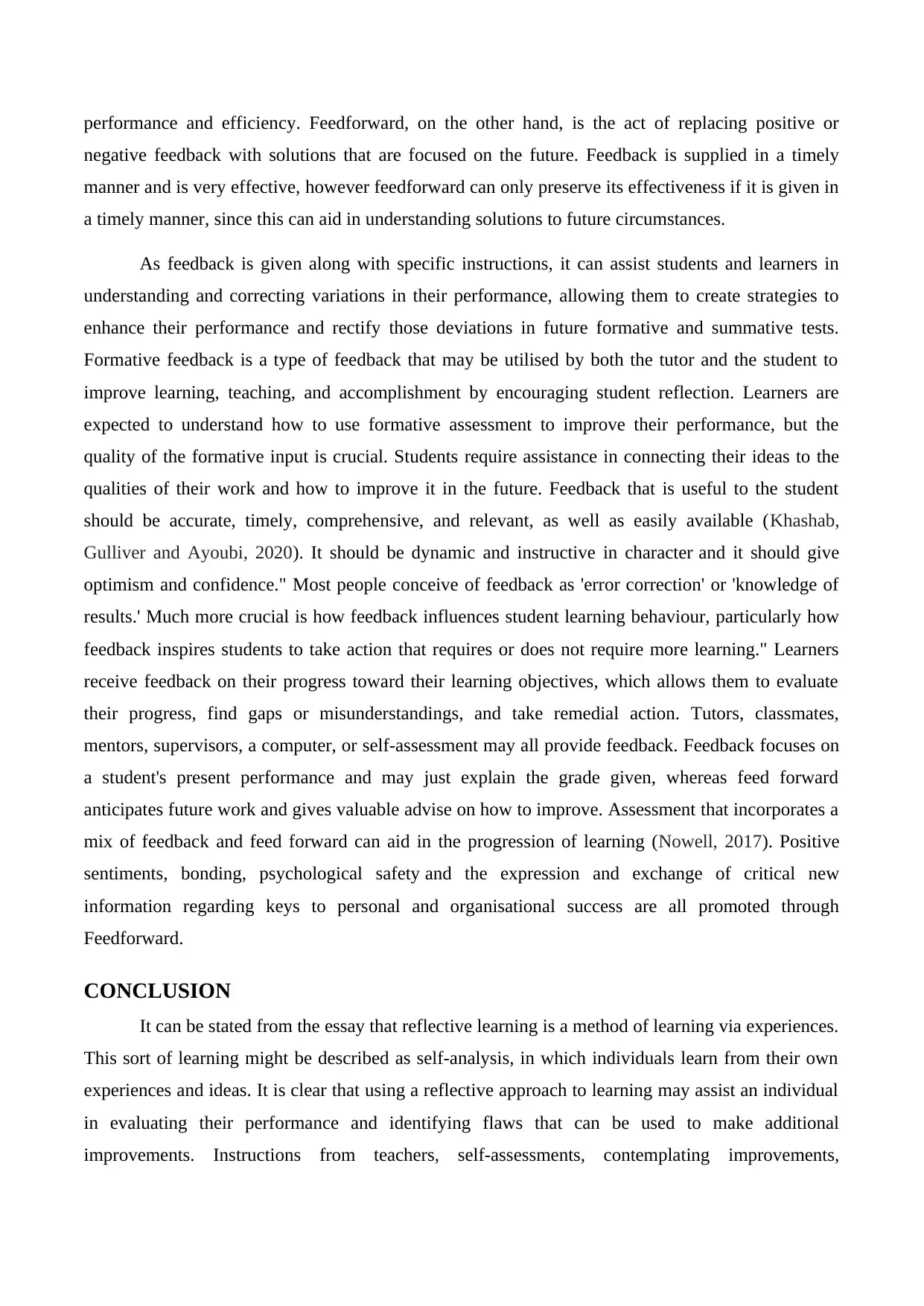
performance and efficiency. Feedforward, on the other hand, is the act of replacing positive or
negative feedback with solutions that are focused on the future. Feedback is supplied in a timely
manner and is very effective, however feedforward can only preserve its effectiveness if it is given in
a timely manner, since this can aid in understanding solutions to future circumstances.
As feedback is given along with specific instructions, it can assist students and learners in
understanding and correcting variations in their performance, allowing them to create strategies to
enhance their performance and rectify those deviations in future formative and summative tests.
Formative feedback is a type of feedback that may be utilised by both the tutor and the student to
improve learning, teaching, and accomplishment by encouraging student reflection. Learners are
expected to understand how to use formative assessment to improve their performance, but the
quality of the formative input is crucial. Students require assistance in connecting their ideas to the
qualities of their work and how to improve it in the future. Feedback that is useful to the student
should be accurate, timely, comprehensive, and relevant, as well as easily available (Khashab,
Gulliver and Ayoubi, 2020). It should be dynamic and instructive in character and it should give
optimism and confidence." Most people conceive of feedback as 'error correction' or 'knowledge of
results.' Much more crucial is how feedback influences student learning behaviour, particularly how
feedback inspires students to take action that requires or does not require more learning." Learners
receive feedback on their progress toward their learning objectives, which allows them to evaluate
their progress, find gaps or misunderstandings, and take remedial action. Tutors, classmates,
mentors, supervisors, a computer, or self-assessment may all provide feedback. Feedback focuses on
a student's present performance and may just explain the grade given, whereas feed forward
anticipates future work and gives valuable advise on how to improve. Assessment that incorporates a
mix of feedback and feed forward can aid in the progression of learning (Nowell, 2017). Positive
sentiments, bonding, psychological safety and the expression and exchange of critical new
information regarding keys to personal and organisational success are all promoted through
Feedforward.
CONCLUSION
It can be stated from the essay that reflective learning is a method of learning via experiences.
This sort of learning might be described as self-analysis, in which individuals learn from their own
experiences and ideas. It is clear that using a reflective approach to learning may assist an individual
in evaluating their performance and identifying flaws that can be used to make additional
improvements. Instructions from teachers, self-assessments, contemplating improvements,
negative feedback with solutions that are focused on the future. Feedback is supplied in a timely
manner and is very effective, however feedforward can only preserve its effectiveness if it is given in
a timely manner, since this can aid in understanding solutions to future circumstances.
As feedback is given along with specific instructions, it can assist students and learners in
understanding and correcting variations in their performance, allowing them to create strategies to
enhance their performance and rectify those deviations in future formative and summative tests.
Formative feedback is a type of feedback that may be utilised by both the tutor and the student to
improve learning, teaching, and accomplishment by encouraging student reflection. Learners are
expected to understand how to use formative assessment to improve their performance, but the
quality of the formative input is crucial. Students require assistance in connecting their ideas to the
qualities of their work and how to improve it in the future. Feedback that is useful to the student
should be accurate, timely, comprehensive, and relevant, as well as easily available (Khashab,
Gulliver and Ayoubi, 2020). It should be dynamic and instructive in character and it should give
optimism and confidence." Most people conceive of feedback as 'error correction' or 'knowledge of
results.' Much more crucial is how feedback influences student learning behaviour, particularly how
feedback inspires students to take action that requires or does not require more learning." Learners
receive feedback on their progress toward their learning objectives, which allows them to evaluate
their progress, find gaps or misunderstandings, and take remedial action. Tutors, classmates,
mentors, supervisors, a computer, or self-assessment may all provide feedback. Feedback focuses on
a student's present performance and may just explain the grade given, whereas feed forward
anticipates future work and gives valuable advise on how to improve. Assessment that incorporates a
mix of feedback and feed forward can aid in the progression of learning (Nowell, 2017). Positive
sentiments, bonding, psychological safety and the expression and exchange of critical new
information regarding keys to personal and organisational success are all promoted through
Feedforward.
CONCLUSION
It can be stated from the essay that reflective learning is a method of learning via experiences.
This sort of learning might be described as self-analysis, in which individuals learn from their own
experiences and ideas. It is clear that using a reflective approach to learning may assist an individual
in evaluating their performance and identifying flaws that can be used to make additional
improvements. Instructions from teachers, self-assessments, contemplating improvements,

development of critical and analytical abilities, and the capacity to resolve disagreements are all
examples of reflective practise.
examples of reflective practise.
⊘ This is a preview!⊘
Do you want full access?
Subscribe today to unlock all pages.

Trusted by 1+ million students worldwide
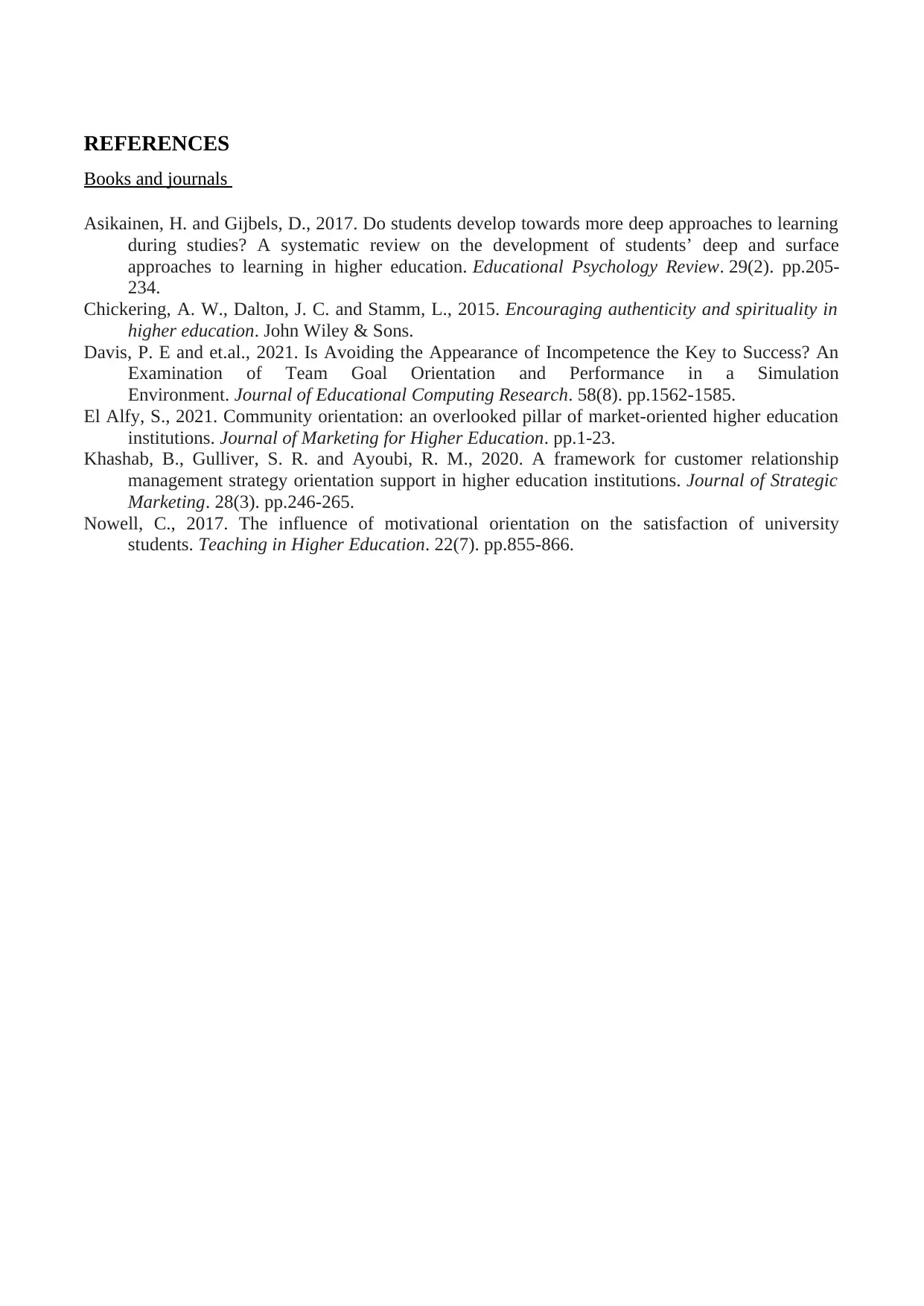
REFERENCES
Books and journals
Asikainen, H. and Gijbels, D., 2017. Do students develop towards more deep approaches to learning
during studies? A systematic review on the development of students’ deep and surface
approaches to learning in higher education. Educational Psychology Review. 29(2). pp.205-
234.
Chickering, A. W., Dalton, J. C. and Stamm, L., 2015. Encouraging authenticity and spirituality in
higher education. John Wiley & Sons.
Davis, P. E and et.al., 2021. Is Avoiding the Appearance of Incompetence the Key to Success? An
Examination of Team Goal Orientation and Performance in a Simulation
Environment. Journal of Educational Computing Research. 58(8). pp.1562-1585.
El Alfy, S., 2021. Community orientation: an overlooked pillar of market-oriented higher education
institutions. Journal of Marketing for Higher Education. pp.1-23.
Khashab, B., Gulliver, S. R. and Ayoubi, R. M., 2020. A framework for customer relationship
management strategy orientation support in higher education institutions. Journal of Strategic
Marketing. 28(3). pp.246-265.
Nowell, C., 2017. The influence of motivational orientation on the satisfaction of university
students. Teaching in Higher Education. 22(7). pp.855-866.
Books and journals
Asikainen, H. and Gijbels, D., 2017. Do students develop towards more deep approaches to learning
during studies? A systematic review on the development of students’ deep and surface
approaches to learning in higher education. Educational Psychology Review. 29(2). pp.205-
234.
Chickering, A. W., Dalton, J. C. and Stamm, L., 2015. Encouraging authenticity and spirituality in
higher education. John Wiley & Sons.
Davis, P. E and et.al., 2021. Is Avoiding the Appearance of Incompetence the Key to Success? An
Examination of Team Goal Orientation and Performance in a Simulation
Environment. Journal of Educational Computing Research. 58(8). pp.1562-1585.
El Alfy, S., 2021. Community orientation: an overlooked pillar of market-oriented higher education
institutions. Journal of Marketing for Higher Education. pp.1-23.
Khashab, B., Gulliver, S. R. and Ayoubi, R. M., 2020. A framework for customer relationship
management strategy orientation support in higher education institutions. Journal of Strategic
Marketing. 28(3). pp.246-265.
Nowell, C., 2017. The influence of motivational orientation on the satisfaction of university
students. Teaching in Higher Education. 22(7). pp.855-866.
1 out of 7
Related Documents
Your All-in-One AI-Powered Toolkit for Academic Success.
+13062052269
info@desklib.com
Available 24*7 on WhatsApp / Email
![[object Object]](/_next/static/media/star-bottom.7253800d.svg)
Unlock your academic potential
Copyright © 2020–2025 A2Z Services. All Rights Reserved. Developed and managed by ZUCOL.